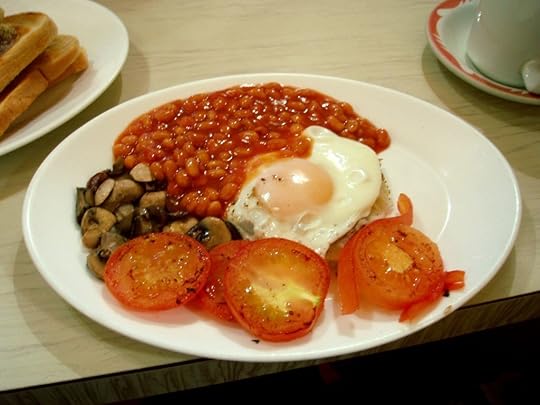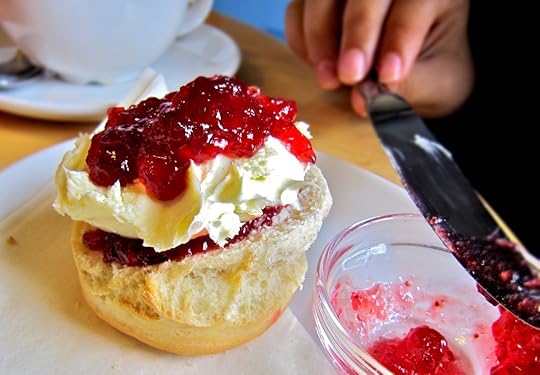The Lowdown on High Tea: Eating in Britain
Let’s talk about British food. I mean, let’s really talk about British food. It’s got a terrible reputation. If you visit, what are you going to find?
Breakfast: Every B & B I’ve ever stayed at offered a full English breakfast—or full Scottish or Irish or Welsh breakfast. In Cornwall, where I live, it’s still, mysteriously, called the full English, although the Cornish aren’t given to calling themselves English. Whatever it’s called, though, it includes an egg, a grilled tomato, a sausage, a piece of bacon, a puddle of baked beans, possibly some fried mushrooms, possibly a piece of black pudding, and definitely some toast set in a rack to cool so it won’t, all the gods of breakfast forbid, melt the better.

The Full English Breakfast. Photo by Ewan Munro, from Wikimedia Commons.
Maybe you have to be born here to love it. It’s heavy and although it isn’t always greasy, it tends to be. It’s also one hell of a lot of food. And on a personal note, I hate baked beans. Especially for breakfast. But if you stay at a B & B, it’s included in the price, so if you’re short on money you’ll eat it. It’ll keep you going till late in the day. If money isn’t tight, you can ask for just one or two items—toast and eggs, maybe, or a single baked bean and a grilled tomato. Or you can just have cereal. I can’t remember a B & B that didn’t offer that as well.
Lunch: Most lunch places serve soups and sandwiches, which range from good to not-so, and many sell jacket potatoes—what we called baked potatoes in the U.S.—as a lunch. You can get them with just butter or you can add a filling, anything from coleslaw to baked beans (they’re everywhere) to cheese to curry. In Cornwall (or Devon—the counties are fighting a war over who invented them) you’ll find pasties. They’re a meal in themselves, and not a light one. Traditionally, the pasty was a miner’s lunch and it was made of beef, potato, and veggies folded inside a crust, but vegetarian and vegan versions are sold pretty much everywhere. I’ve eaten enough that I’ve started to notice how greasy they are, but you can’t say you’ve visited the southwest unless you’ve tried one, and they are good.
Afternoon Tea: The British really do love afternoon tea. It’s not necessarily fancy—usually just a cup of tea and something baked, and almost anything baked is worth trying. Scones (unless they’re inside a cellophane package) are almost universally good. Cornish (or let’s be generous: Devon) cream tea is magnificent: scones, jam, and a heavy, unsweetened cream called (don’t let the name put you off) clotted cream. Cornwall and Devon can’t agree on who invented the cream tea or on whether to put the jam or the cream on first. My advice? You’re a visitor; do a little of each and avoid offending anyone.

Cream Tea, with Jam on Top and Bottom to Avoid Offending Anyone. Photo by Foowee, from Wikimedia Commons.
Fruit pies are made with a slightly sweet crust. Since I’m American, I’m used to—and actually like—pie crusts that taste like cardboard, but I love the British version. Ginger cake is also wonderful, and coffee cake is actually made with coffee—another surprise for an American, since our coffee cake got its name from being eaten with coffee instead of being made with it. That’s a random sampling. If you can try everything, do.
Evening Meals: These pretty much divide into (a) carryout, (b) ethnic food, (c) pub or, in cities, café food, and (d) restaurant food.
Carryout: In small towns, this will probably be a kebab shop or a fish n’ chip place. In cities, you’ll find a wider range. This is your cheapest option.
Ethnic food: A small and unscientific survey reveals that every town has at least one Indian restaurant. Cities will have a wider range. They’re not necessarily cheap, but many are good.
Pubs and cafes: Pub grub is traditional British food. I wouldn’t say it’ll send you into ecstasy, but it will fill you up. Some pubs have gone high-end and call themselves gastro pubs, with fancier menus and fancier prices. In cities, you may find cafés—informal, lunch-y places—that stay open in the evening and serve evening meals, but in the countryside, where I live, cafes close by late afternoon.
Restaurants: These tend to be fancier than pubs, and pricier. You’ll find menus outside the doors so you can check prices and offerings. Britain’s in the throes of a food revolution and I’m told that some of the high-end restaurants are very good. I’ve never seen the point in spending silly amounts of money on a meal, so I can’t testify on this.
Vegetarian Food: I have yet to find a place that didn’t offer a vegetarian choice, and sometimes a vegan one. It doesn’t always thrill me, but it does fill me up.
Want to read more from Ellen Hawley? Buy her book: The Divorce Diet due out December 30, 2014
The post The Lowdown on High Tea: Eating in Britain appeared first on We Said Go Travel.
We Said Go Travel
We Said Go Travel is a global community of over sixteen hundred writers with articles from every continent.
Stories are shared with photos and video from a perspective of the transformative power of travel. We Said Go Travel has hosted live and online events as well as travel writing contests around the world. ...more
- Lisa Niver's profile
- 57 followers



